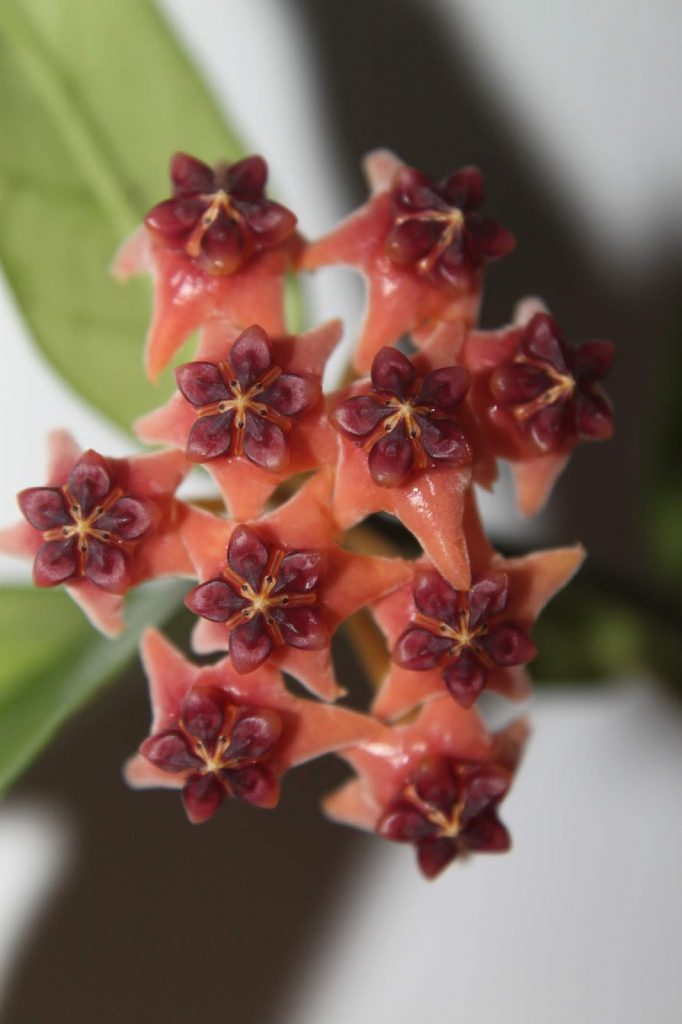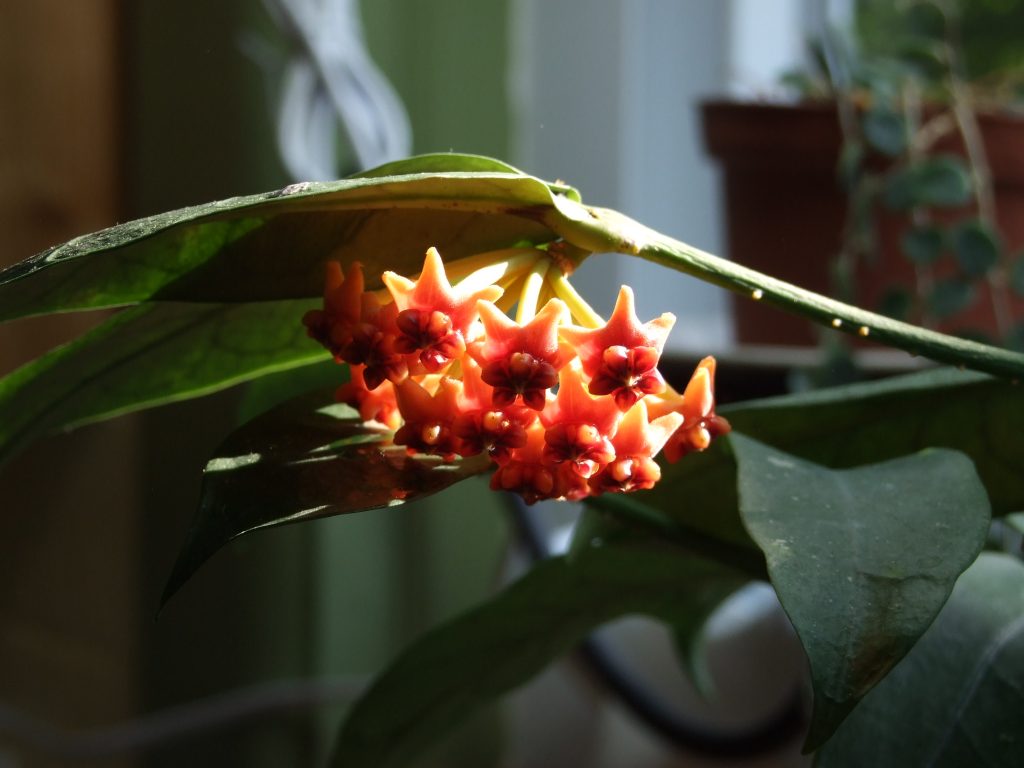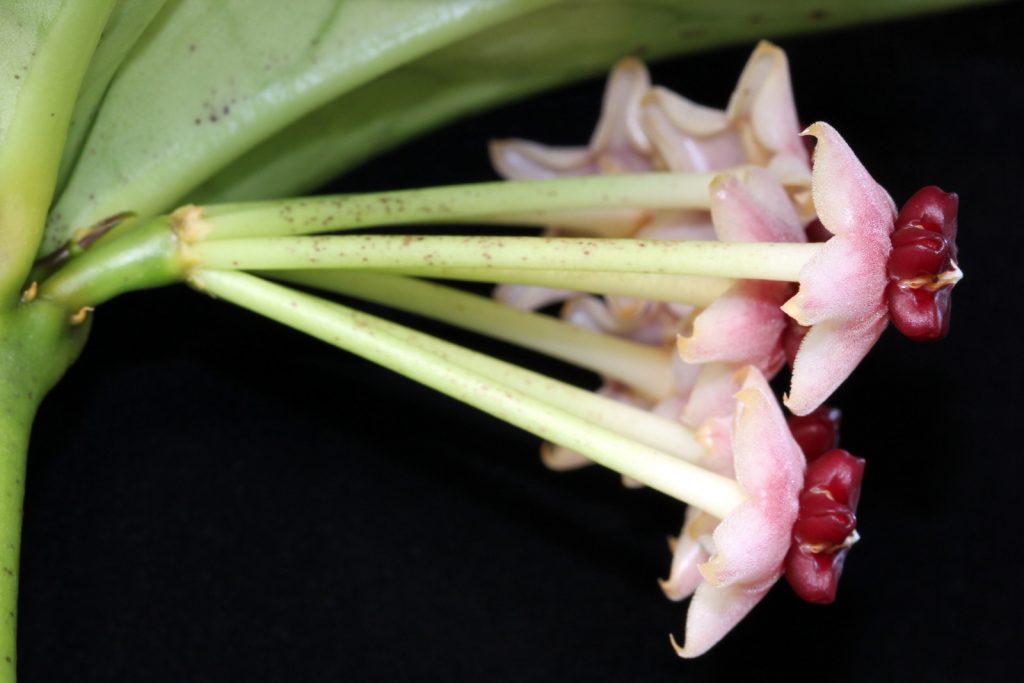Hoya Lobby - Growing Tips
Hoya Lobby is a bushy vine from the Lastovnev family. She was named after the discoverer T. Lobb, who tracked her down in the Indian mountains. In natural conditions, the flower is found in India, Thailand, Burma. Due to its unpretentiousness and beautiful flowering, the hoyka is in great demand in home cultivation.

Hoya lobby photo
Description
Hoya Lobby does not branch like other vines, but grows as a bush, reaching a height of 100 cm. Usually it is grown in a pot with a high support. The diameter of the bush is 30-50 cm. Leaves grow in pairs, sometimes - 4 pieces. They are quite large - up to 10-12 cm in length, rich green with rare light specks.
The flowers are small (about 2 cm), dense, like bright wax toys, as if illuminated from the inside. The corolla is pink, cream or crimson, with a glossy surface and velvety pubescence. The crown is dark purple with a white center.
Flowers are collected in lush umbellate inflorescences of 15-25 pieces. Hoyka blooms all summer and the first part of autumn, exuding a sweetish aroma in the evening.
Varieties
The Lobby variety has several variations, which differ in the color of the flowers:
- Cream whith red is a common subspecies with soft cream corollas and a purple crown. The petals can also be slightly pinkish with a tendency towards red in the light.
- Black (Black) - the original variety with a black center. At the same time, corollas are pink, crimson, inky-burgundy.
- Dark red (Dark Red) - a spectacular subspecies with flowers of dark red shades. The crown may be significantly darker or approximately the same color as the petals.
Purchase and adaptation
Hoyka Lobby is not often found in regular flower shops, but it can be found on the Internet through advertisements for sale. At the same time, cuttings are more often offered than adult plants.

Hoya lobby cream
For a cut, they ask about 250-350 rubles, for a rooted one - 1000-1200 rubles. A two-three-year-old vine is several times more expensive.
When buying, make sure that there are no foreign spots, dry leaves and roots on the hoyka. Set it apart from the rest of your house flowers for a couple of weeks.
Do not prune hoya, feed or transplant. Provide it with diffused lighting, a temperature of 20-22 ° C and regular but moderate watering.
Landing rules
Hoyke needs loose, light soil with good drainage. You can mix leafy earth with perlite, peat and pieces of bark, after having disinfected all components (by calcining, freezing or steaming). An excellent option would be a store-bought substrate for orchids or succulents.
Technology:
- A drainage layer of expanded clay or broken brick is laid at the bottom of the container
- Hoya is transferred from an old pot along with an earthen lump.
- A support is installed to secure the vines.
- Pour the substrate between the walls and the plant, gently ram.
- The hoyka is poured with lukewarm, settled water.
The necessary conditions
Hoye Lobby needs moderate humidity.Sprays and warm showers are good for her. The room should be regularly ventilated, but drafts should not be allowed.
Liana doesn't like the heat too much. In summer, she is more comfortable at 20-22 ° С, and in winter, the temperature should not fall below 15 ° С. Hoyke needs diffused lighting or shading at noon. In addition, it grows well with artificial supplementary lighting.
Care
Hoyka Lobby in nature lives on rocky ground, so it is not too whimsical and hardy enough. She needs regular but moderate watering, sanitary pruning as needed. Top dressing is not necessary, but in the summertime, they contribute to a longer and more abundant flowering.

Hoya lobby dark ed
Watering
Water the liana 1-2 times a week with soft, settled water at room temperature. To soften the water, you can add a little manganese, which will also create disease prevention. When watering, it is important to focus on the condition of the soil - the top layer should have time to dry out. If moisture stagnates in a flowerpot, the roots will rot.
Top dressing
The substrate in which the hoya is planted already contains nutrient components, so you can not feed the liana, but only change the soil mixture during transplantation. However, in the spring and during the flowering period, additional feeding will help it grow more beautiful flowers. The best choice would be a ready-made mineral complex for orchids and succulents: it is diluted in water and applied 1-2 times a month after watering. In this case, it is better to reduce the amount of the substance by half of the dose indicated on the package.
Transfer
While the vine is in the active growth stage, it is transplanted every spring. An adult plant can do without transplanting for 3-5 years. When the roots are completely entwined with an earthen ball and begin to look out of the drainage holes, it is time to change your place of residence to a more spacious one.

Hoya lobby cream photo
Pruning
Hoya is pruned as needed, removing only damaged, dried leaves and shoots. Places of cuts are powdered with crushed coal or other antiseptic.
You cannot cut dry peduncles - new flowers will grow on them next season.
Reproduction
Hoya Lobby is propagated by cuttings.
Sometimes it is grown from seed and leaf rooting, but both methods are laborious and not entirely reliable.
For cuttings, shoots with two nodes are cut, the lower leaves are cut off and the cut is treated with a root formation stimulator.
Root liana in water or in a wet mixture of perlite and peat. From above, the plant is covered with a film, bag or plastic cup, creating the effect of a greenhouse. The cuttings are placed in heat (20-24 ° C), regularly ventilated and, as necessary, moisten the substrate. When the hoyks release new leaves, they can be transplanted into permanent containers.
Diseases and pests
| Problem | Symptoms | Prophylaxis | Treatment |
| Shield | Insects in the form of dark brown plaques on leaves and stems. | Spraying, showering, regular airing, quarantine for new plants. | Rinse the vine with laundry or tar soap, and then dip it under a warm shower. Remove the remaining pests by hand (with a brush). If the shield is not displayed, treat the hoya with Fitoverm. |
| Aphid | Light green small bugs. Leaves curl, deform and dry out. | The same as for the prevention of the scabbard. | Cut off twisted leaves, wash the plant with soapy water. Use insecticides for serious injury (Intavir, Fas, Karate). |
| Root and stem rot | Liana stops growing. Dark and soft patches appear on the stems. The leaves wither and fall. | Correct watering, without waterlogging. Disinfection of a pot, drainage, tools. | Cut off damaged parts of the plant. Spray with fungicide (Trichodermin, Mikosan, Topaz). Transplant the vine into a healthy new substrate. |

